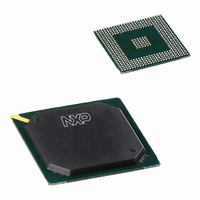PNX1502E,557 NXP Semiconductors, PNX1502E,557 Datasheet - Page 364

PNX1502E,557
Manufacturer Part Number
PNX1502E,557
Description
IC MEDIA PROC 300MHZ 456-BGA
Manufacturer
NXP Semiconductors
Specifications of PNX1502E,557
Applications
Multimedia
Core Processor
TriMedia
Controller Series
Nexperia
Interface
I²C, 2-Wire Serial
Number Of I /o
61
Voltage - Supply
1.23 V ~ 1.37 V
Operating Temperature
0°C ~ 85°C
Mounting Type
Surface Mount
Package / Case
456-BGA
Lead Free Status / RoHS Status
Lead free / RoHS Compliant
Program Memory Type
-
Ram Size
-
Lead Free Status / Rohs Status
Not Compliant
Other names
935274744557
PNX1502E
PNX1502E
PNX1502E
PNX1502E
Available stocks
Company
Part Number
Manufacturer
Quantity
Price
Company:
Part Number:
PNX1502E,557
Manufacturer:
NXP Semiconductors
Quantity:
10 000
- Current page: 364 of 828
- Download datasheet (8Mb)
Philips Semiconductors
Volume 1 of 1
PNX15XX_SER_3
Product data sheet
2.3.4 Chroma Upsample Filter (CUPS)
2.3.5 Linear Interpolator (LINT)
2.3.6 Video/Graphics Contrast Brightness Matrix (VCBM)
The chroma (chrominance) upsampling module allows conversion of YUV 4:2:2 data
streams to 4:4:4 data streams by interpolating the missing chrominance information.
There exist two forms of 4:2:2 co-sited and interspersed. It depends on how the U&V
data was down-sampled from 4:4:4 to 4:2:2. Since both co-sited and interspersed
4:2:2 formats (as shown in
CUPS should be adapted accordingly. This feature is necessary for supporting RGB/
YUV outputs in full-color resolution.
The linear interpolator is used for horizontal up-scaling of graphics images. It is
specifically used for graphics images because its nature makes it unsuitable for
quality scaling of video material. However, due to its small size, the block is present in
both layers of QVCP. This unit supports up-scaling only, and can handle both YUV
and RGB data streams. It also supports scaling of the alpha channel as well as any
potential previously-extracted color keys. The output samples are calculated from the
input samples via a piece-wise linear interpolator. All pixel components are treated
equally.
Remark: Layer Size (final)) register has to be updated to match the scaled width, if
LINT scaling is changed.
The first purpose of VCBM is contrast (gain) and brightness (offset) control (in that
order). The contrast and brightness controls are for normalizing the amplitude (black
and white level) of all sources. They also permit balancing the visibility of all video
and graphics layers. An important benefit of having separate controls for all video and
graphics layers is that the user interface never needs to disappear, even if the user
tries to make (the video part of) the picture invisible. This benefit should be achieved
by control software: limit the control range for the user interface layers.
Figure 4:
4:2:2 Input
Co-Sited
Interspersed
4:4:4 Output
4:2:2 and 4:4:4 Formats
Rev. 3 — 17 March 2006
(U0, V0)
(U0, V0)
(U0, V0)
Figure
(U1, V1)
first luma, alpha samples in each line (Y0, A0)
chroma (U, V) samples
chroma (U, V) samples
4) are supported, the up-sampling method of
(U2, V2)
(U2, V2)
(U2, V2)
(U3, V3)
luma, alpha (Y, A) samples
(U4, V4)
(U4, V4)
© Koninklijke Philips Electronics N.V. 2006. All rights reserved.
(U4, V4)
luma (Y) samples
PNX15xx Series
(U5, V5)
(U6, V6)
(U6, V6)
Chapter 11: QVCP
(U6, V6)
(U7, V7)
11-11
Related parts for PNX1502E,557
Image
Part Number
Description
Manufacturer
Datasheet
Request
R
Part Number:
Description:
Digital Signal Processors & Controllers (DSP, DSC) MEDIA PROCESSOR PNX15XX/300MHZ
Manufacturer:
NXP Semiconductors

Part Number:
Description:
IC MEDIA PROC 300MHZ 456-BGA
Manufacturer:
NXP Semiconductors
Datasheet:
Part Number:
Description:
NXP Semiconductors designed the LPC2420/2460 microcontroller around a 16-bit/32-bitARM7TDMI-S CPU core with real-time debug interfaces that include both JTAG andembedded trace
Manufacturer:
NXP Semiconductors
Datasheet:

Part Number:
Description:
NXP Semiconductors designed the LPC2458 microcontroller around a 16-bit/32-bitARM7TDMI-S CPU core with real-time debug interfaces that include both JTAG andembedded trace
Manufacturer:
NXP Semiconductors
Datasheet:
Part Number:
Description:
NXP Semiconductors designed the LPC2468 microcontroller around a 16-bit/32-bitARM7TDMI-S CPU core with real-time debug interfaces that include both JTAG andembedded trace
Manufacturer:
NXP Semiconductors
Datasheet:
Part Number:
Description:
NXP Semiconductors designed the LPC2470 microcontroller, powered by theARM7TDMI-S core, to be a highly integrated microcontroller for a wide range ofapplications that require advanced communications and high quality graphic displays
Manufacturer:
NXP Semiconductors
Datasheet:
Part Number:
Description:
NXP Semiconductors designed the LPC2478 microcontroller, powered by theARM7TDMI-S core, to be a highly integrated microcontroller for a wide range ofapplications that require advanced communications and high quality graphic displays
Manufacturer:
NXP Semiconductors
Datasheet:
Part Number:
Description:
The Philips Semiconductors XA (eXtended Architecture) family of 16-bit single-chip microcontrollers is powerful enough to easily handle the requirements of high performance embedded applications, yet inexpensive enough to compete in the market for hi
Manufacturer:
NXP Semiconductors
Datasheet:

Part Number:
Description:
The Philips Semiconductors XA (eXtended Architecture) family of 16-bit single-chip microcontrollers is powerful enough to easily handle the requirements of high performance embedded applications, yet inexpensive enough to compete in the market for hi
Manufacturer:
NXP Semiconductors
Datasheet:
Part Number:
Description:
The XA-S3 device is a member of Philips Semiconductors? XA(eXtended Architecture) family of high performance 16-bitsingle-chip microcontrollers
Manufacturer:
NXP Semiconductors
Datasheet:

Part Number:
Description:
The NXP BlueStreak LH75401/LH75411 family consists of two low-cost 16/32-bit System-on-Chip (SoC) devices
Manufacturer:
NXP Semiconductors
Datasheet:

Part Number:
Description:
The NXP LPC3130/3131 combine an 180 MHz ARM926EJ-S CPU core, high-speed USB2
Manufacturer:
NXP Semiconductors
Datasheet:

Part Number:
Description:
The NXP LPC3141 combine a 270 MHz ARM926EJ-S CPU core, High-speed USB 2
Manufacturer:
NXP Semiconductors

Part Number:
Description:
The NXP LPC3143 combine a 270 MHz ARM926EJ-S CPU core, High-speed USB 2
Manufacturer:
NXP Semiconductors

Part Number:
Description:
The NXP LPC3152 combines an 180 MHz ARM926EJ-S CPU core, High-speed USB 2
Manufacturer:
NXP Semiconductors











